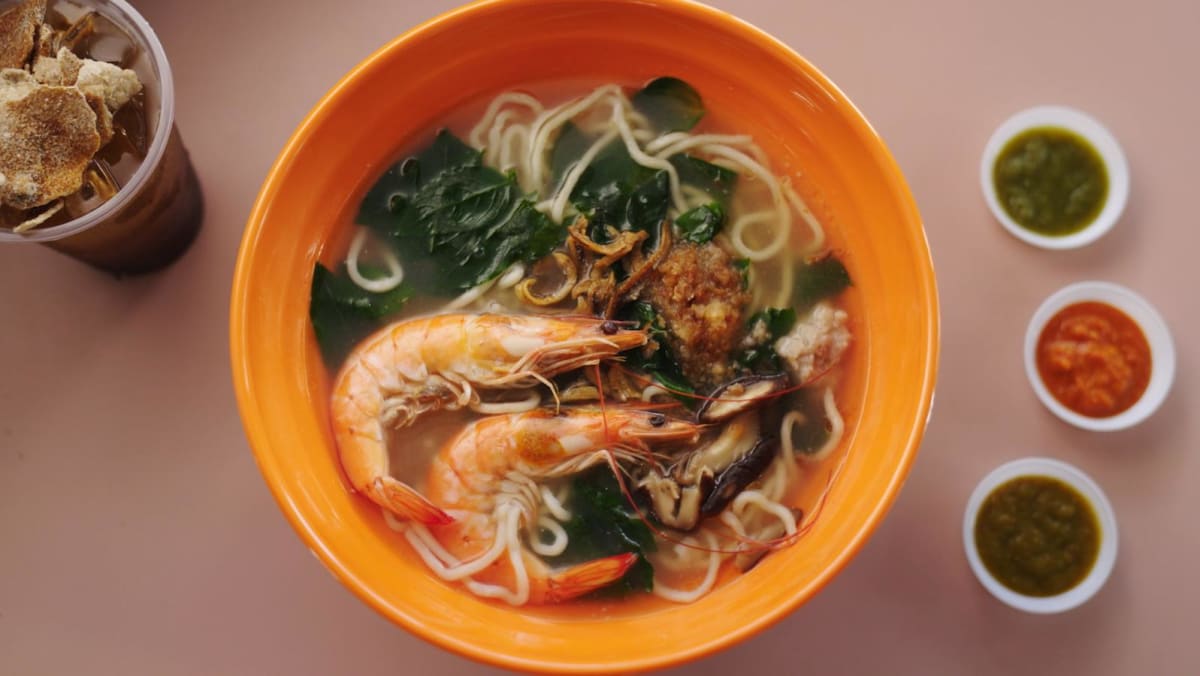After several delays due to laryngitis (on my part), meeting up with my next Makan Kaki was an exercise in planning and patience (on her part). But private hire driver Alice Kee is used to handling such situations, having worked in logistics and inflight catering previously.
Even though she was under the weather when we finally met, she was excited to show me her go-to stall for comfort food. And as I later discovered, it was the perfect meal for two ailing foodies. As I drove us to Whampoa Makan Place for handmade noodle soup, Alice shared why she made the career switch, after making a living in Malaysia and Indonesia for 20 years.
She ordered us her usual – Number 1 on the signboard – meatballs and prawns in soup (S$5, S$6 or S$7) with a choice of noodles – ban mian (straight-cut and flat), mee hoon kueh (hand torn pieces) or you mian (thin and circular). The latter is always Alice’s pick for its chewy snap and the way it handles when pulled from the soup.
Stall owner Mr Ng told me that those three noodle varieties are made fresh daily in one location before being distributed to his three stalls. Besides the original in Whampoa, he has branches at Fernvale Food Centre and Senja Hawker Centre. For variety, he also sells bee hoon, Hong Kong mee, instant noodles and bean flour noodles (tau chiam). All can be served with a smorgasbord of ingredients, including fish slices, baby abalone and pig kidneys.
Despite having lived in the area since 1997, Alice only recently discovered the stall. “I’ve been living in this community for almost 30 years, but I never noticed this because it’s not to my palate. I always thought of it as ‘sick man food’,” she said. And in a way, she was not wrong.
Brought home by her husband when she was recovering from COVID-19, the soupy noodles were the perfect convalescent meal. “It was a mind-blowing experience. After that, we always go back. My mother-in-law and I have to have it at least once every two weeks.” she said.
For Alice, the best thing about China Home Made Noodle is their use of “mani cai”, a wild plant native to Southeast Asia, also known as sayur manis (literally “sweet vegetable” in Malay) or Sabah vegetable, because it’s believed to have first been commercially cultivated in that region of Malaysia. I had to admit I was completely unfamiliar with it.
Alice agreed: “Most places that sell ban mian do it with spinach because it’s difficult to get. It has nostalgic value. When I was younger, my grandmother used to cook it for us.” Which made her accidental discovery of the stall even sweeter.
Mr Ng explained: “It’s traditional, a must in ban mian. It makes our noodles special. We’ve always used this vegetable. It’s more fragrant. Unless it’s unavailable then we’ll use cai xin. But the taste is different. It’s like eating laksa or char kway teow without hum (cockles). It would be strange.”
Related:
Charcoal-grilled satay and BBQ chicken wings by the beach at East Coast Park
Perfectly balanced popiah in Bukit Timah that's simple but far from basic
Perfect rainy day breakfast combo: Lontong and sotong from Java Corner in Stirling Road
True to its name, the mani cai was a little sweet, with a hint of bitterness and herbal freshness coming through. The deep green leaves had a uniquely firm texture and the more I chewed, the more flavour they released. Combined with the delicious soup made from brewed ikan bilis (dried anchovies) and soya beans, it was like drinking a tasty medicinal elixir. My throat was soothed and my taste buds satisfied.
“Singaporeans like something healthy. But we also like something with spice, a kick to it,” Alice said, encouraging me to try Mr Ng’s trio of condiments: Original garlic red chilli paste, pineapple chilli paste and lime green chilli paste.
Available to purchase in take-home jars, the triple whammy of flavour and fire is a more recent addition to the China Whampoa menu, cooked up after he took over stall duties from his mother.
My favourite was the original chilli – an intense wallop of sinus-clearing garlic heat with an underlying hint of sweetness. The pineapple chilli amped up the sweetness with its fruity zing and the green chilli popped with a fresh, citrusy burn. I appreciated being able to mix and match the flavour profiles and heat levels to our preference.
Dipping a meatball in the garlic chilli, I realised how luscious and tender the rustic, hand-formed orb of fatty ground pork was. Bits of tee po (dried flat fish) also imbued the mince with satisfying umami.
“This is my mother-in-law’s and also my favourite. We always order extra. They make it every day – fresh! Not too soft, not too hard, and you still get a meaty bite,” Alice said fervently.
Juicy slices of shiitake mushroom echoed the meatiness, savoury ikan bilis and fragrant fried shallots added crunch and two shell-on prawns completed the Number 1 special. “These are very easy to handle because they are very fresh,” promised Alice. Lazy eaters will be glad to note that the prawn shells slid off easily with just a flick of chopsticks.
It was easy to see why China Whampoa has made a deep impression on Alice. Mr Ng’s mother started the family-run stall in 1989 and the maternal touch is evident in their consistency and attention to detail.





